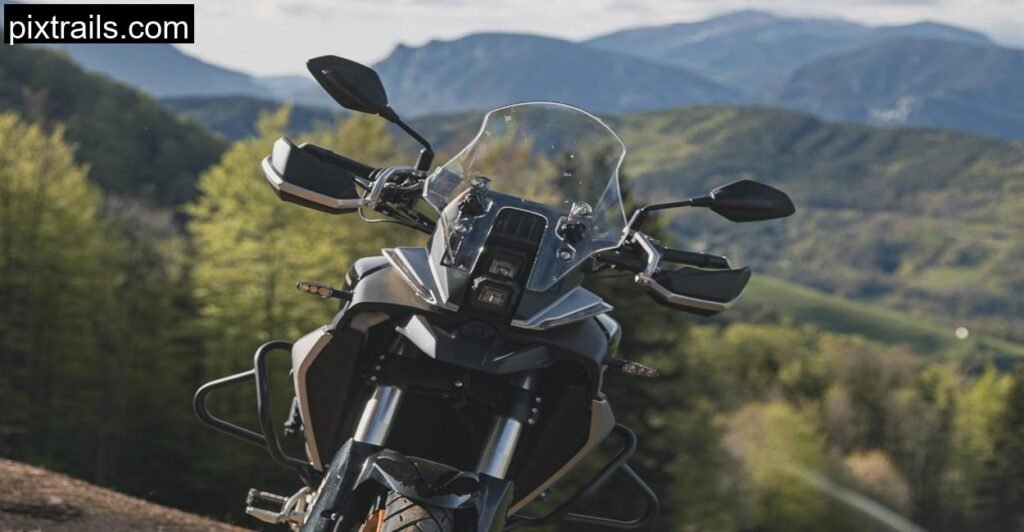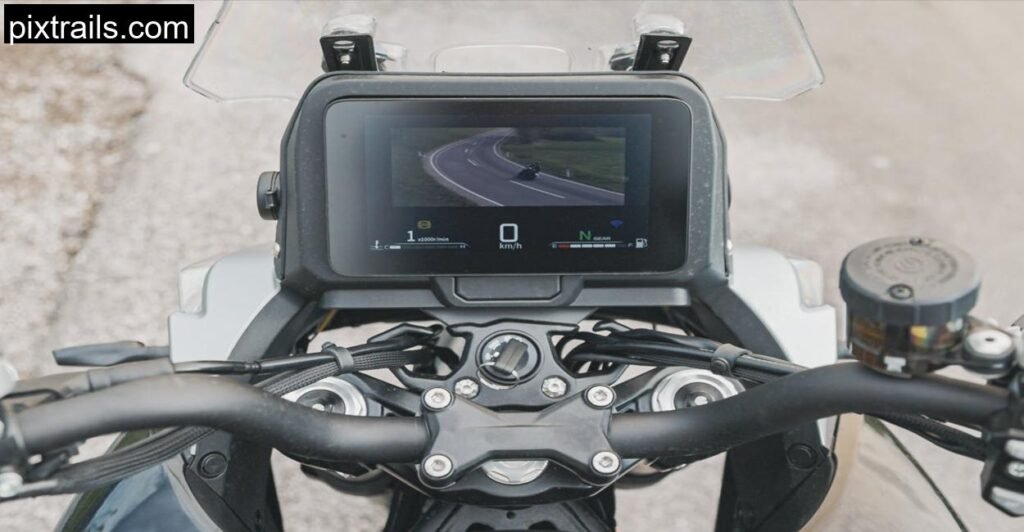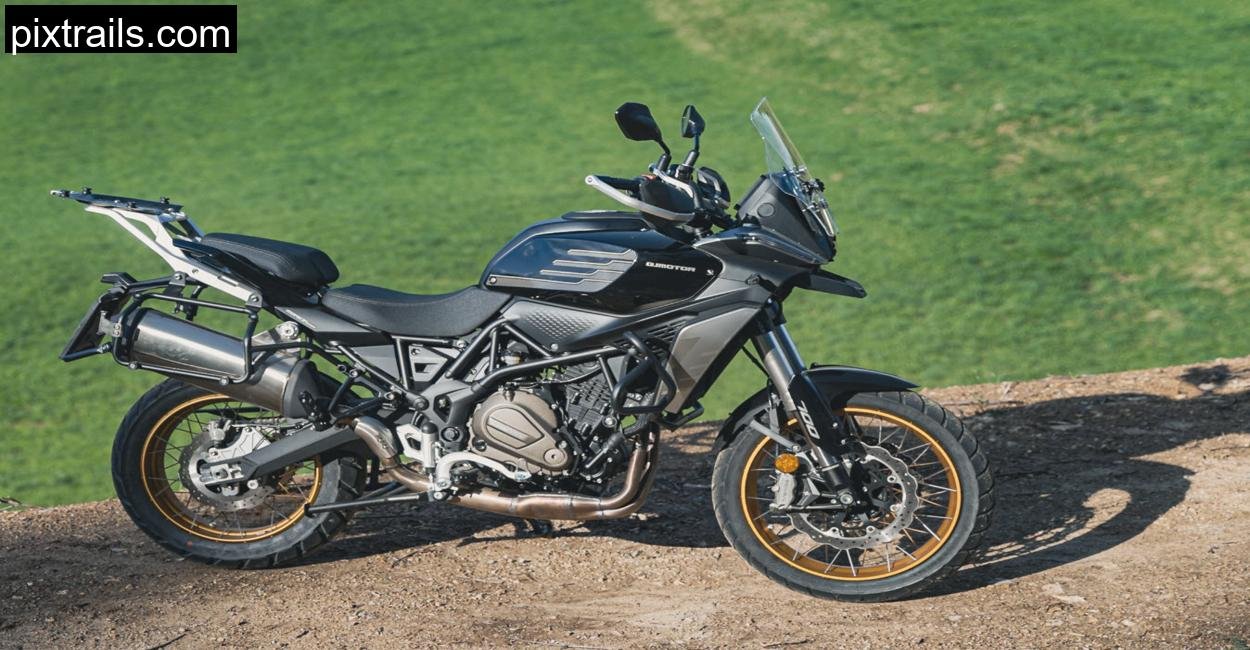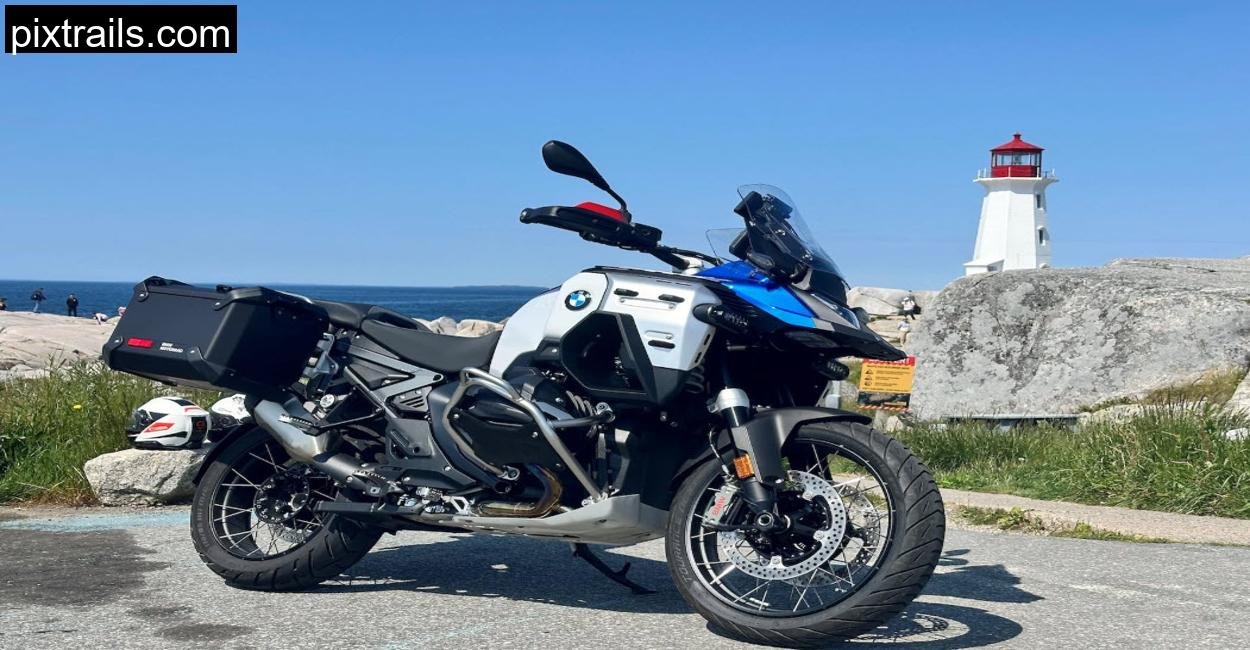When I rolled into Bomerano, the little Italian village clinging to the slopes of the Amalfi Coast, the air smelled like fresh espresso and salty sea breeze. Narrow cobbled streets twisted between pastel houses, and the chatter of locals echoed under the morning sun. It’s the kind of place where time slows, unless you happen to be astride 264 kilograms of Chinese-Italian touring ambition, pointing toward the winding roads that snake across the coast.
I was here to put the QJ Motor SRT 700 SX through its paces. On paper, it’s an incredible deal: under €8,000, and that’s with a full set of aluminum panniers, crash bars, center stand, TFT dash, and more tech than some bikes twice the price. But paper is one thing. I wanted to see what it’s like when the Amalfi road throws its first tight hairpin at you, when you need to squeeze the brakes hard after an unexpected Fiat Panda appears in your lane, when the bike is loaded for a week on the road.
And, maybe, when you’re just idling at a café, sipping an espresso, letting the locals admire the bold styling.
First Impressions in the Amalfi Light
From a distance, the SRT 700 SX looks premium. The sharp fairing lines, crash protection, and the glint of those three aluminum boxes say “ready for a round-the-world tour.” The panniers lock with the bike key, no fiddling with separate locks, and feel robust enough to take a knock from a careless scooterist in Naples traffic.
Throwing a leg over, I immediately noticed the generous seat space. At 845 mm, the seat height puts me just about flat-footed (I’m 1.82 m), and there’s a sofa’s worth of room for the passenger. The top case even doubles as a backrest. But the riding position? That’s where the first wrinkle appeared. The bars are angled back more like a cruiser than an adventure bike, making my arms feel oddly tucked. The gear lever sat just a bit too low, and my knees found themselves awkwardly pressing against the tank’s shape.
It’s the kind of thing you could adjust at home with an Allen key and a free afternoon. But here in Bomerano, we had roads to ride, and the real test was ahead.
Technical Specifications
All technical details provided are taken from the QJ Motor’s official manufacturer site. Specifications are based on the most recent data available at the time of review.
| Specification | QJ Motor SRT 700 SX (2025) |
| Engine Type | 698 cc parallel twin, liquid-cooled |
| Power Output | 70 hp @ 8,000 rpm |
| Torque | 70 Nm @ 6,000 rpm |
| Gearbox | 6-speed manual |
| Weight (ready to ride, no cases) | 246.5 kg |
| Weight (with panniers) | 264 kg |
| Seat Height | 845 mm |
| Fuel Tank | 19.5 liters |
| Suspension (front/rear) | Marzocchi, 150 mm travel, preload adjustable (plus hidden compression/rebound) |
| Brakes | Brembo, dual 4-piston calipers, ABS (non-switchable) |
| Electronics | 7-inch TFT with smartphone mirroring (Carbit Ride app), LED lighting, USB A + C |
| Price (Italy, 2025) | €7,990 (incl. pannier set) |
The Engine: Numbers vs. Feel

Leaving Bomerano means climbing, and climbing means hairpins. The QJ’s 698 cc parallel twin promised 70 horsepower and 70 Nm of torque, respectable for its class. But as I rolled on the throttle out of the first few bends, I felt the gap between spec sheet and seat-of-the-pants reality. Below 4,000 rpm, the bike felt lazy, almost hesitant, as if it was still deciding whether it really wanted to go.
Push it past 5,000 rpm, and it wakes up, but you pay for it in vibrations. On the Amalfi Coast road, that wasn’t a huge problem, the scenery and curves demand constant throttle changes anyway, but on the autostrada later that day, holding 120 km/h meant my hands, feet, and seat all tingled with the high-frequency buzz.
It’s not a bad engine if you treat it as a steady tourer, but if you want punchy, low-down grunt, you’ll be looking at other twins in this segment.
Weight and Balance: The Amalfi Reality Check
With panniers loaded for a week (tools, rain gear, and a camera that weighs almost as much as a Vespa), the SRT tipped the scales at 264 kilograms. That’s heavy for a mid-size adventure bike. On the wide sweepers above Positano, the weight didn’t bother me. The Marzocchi suspension, plush and forgiving in stock trim, smoothed over patched tarmac and even handled the odd cobblestone section without drama.
But in the tightest switchbacks, the kind where you almost need to reverse halfway through, I felt every kilo. The bike demanded deliberate counterweighting, and low-speed U-turns required planning. Maneuvering it in a cramped hotel courtyard? Let’s just say I was sweating as much as the bike’s radiator fan.
Comfort, Suspension, and the Marzocchi Surprise

One of the big wins for the QJ is comfort. The seat is a proper touring perch, wide and supportive, and with the optional heated grips and heated seat on my test bike, chilly morning rides along the coastal ridge were downright luxurious.
The suspension was another surprise. The brochure says only preload is adjustable, but tucked away in the hardware are hidden adjusters for compression and rebound. Once I found them (and cursed their inaccessibility behind fairing panels), I stiffened the setup slightly, and the handling improved noticeably without losing comfort. At €7,990, having Marzocchi hardware with that level of adjustability is impressive.
Brakes and Electronics: Big Names, Mixed Results

Brembo brakes should inspire confidence, but here they were more “adequate” than “exceptional.” The pressure point felt vague, and while stopping power was fine for everyday riding, aggressive mountain descents required more lever squeeze than I’d like. And because the ABS can’t be switched off, riders with off-road ambitions will find it limiting on loose terrain.
On the electronics front, QJ delivers a bit of a wow factor: a bright, large TFT that mirrors your phone via the Carbit Ride app. I had Calimoto running for navigation, and it felt like something from a much pricier bike. There’s even the potential to play YouTube, though I’ll pretend I never discovered that feature. However, the switchgear felt cheap, and the lack of backlighting on the buttons made night riding a game of “guess that switch.”
Touring Life: Living With the QJ on the Road
In the real world, the SRT 700 SX is a comfortable, practical, value-packed tourer. The panniers swallowed everything I needed for a week, and the top case easily took my adventure helmet. I especially liked the little interior compartments for documents, a thoughtful touch.
Fuel consumption hovered around 5.5 L/100 km, giving me a real-world range just over 300 km. Not the best in class, but enough that I could ride from Bomerano to Rome with just one fuel stop. The downside? Frequent service intervals mean you’ll be seeing your dealer more often than you might like.
Conclusion: A Lot of Bike for the Money, If You Accept Its Flaws
Riding the QJ Motor SRT 700 SX through the twisty, scenic, sometimes chaotic roads of Italy made its strengths and weaknesses clear. For under €8,000, you get a fully equipped touring machine with comfort, luggage, and some tech usually reserved for pricier bikes. But you also get an engine that needs revs, noticeable vibrations, heavy handling at low speeds, and brakes that could use an upgrade.
If you’re the kind of rider who values features and comfort over outright performance, and you don’t mind a bit of tinkering with ergonomics, this bike could be a fantastic budget-friendly touring partner.
Is the QJ Motor SRT 700 SX good for long-distance touring?
Yes, thanks to its comfortable seat, optional heating, and ample luggage capacity, it’s well-suited for multi-day rides.
How does QJ Motor SRT 700 S handle in tight corners?
It’s stable but heavy, especially with panniers. Low-speed turns require care.
What’s the fuel range for QJ Motor SRT 700 S?
About 300 km in real-world riding, with a 19.5-liter tank.











